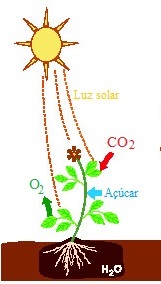The life cycle of pteridophytes, as well as the cycles of other plant groups, is marked by the alternation of generations, being possible to observe a gametophytic and a sporophytic generation. In this cycle, which depends on water to happen, we see the sporophytic generation as the dominant phase, that is, the spore-producing phase.
Pteridophytes are a group of plants that stands out for being the first plant group to have sap conducting vessels (xylem and phloem). This group of plants is often called seedless vascular plants. As an example of pteridophytes, we can mention ferns, maidens and horsetails.
→ Summary
Pteridophytes are seedless vascular plants that reproduce asexually and sexually. When we look at sexual reproduction, we see a cycle with alternating generations. See below the main stages of the life cycle of a fern, a typical example of pteridophyte:

Ferns are examples of pteridophytes.
The fern (sporophytic phase) has leaves that contain sera, small brown dots in which spores are produced.
The spores fall into the environment and germinate.
The spores give rise to the gametophyte, known as prothalus.
Prothallus is a generally bisexual gametophyte that has archegones and antheridia, in which the oosphere (female gamete) and anterozoids (male gametes) will be produced, respectively.
In the presence of water, anterozoids swim to the archegon, where the oosphere is.
In ferns that produce bisexual gametophytes, antheridia and archegonian maturation is observed at different times. Thus, anterozoids will fertilize the oosphere of another gametophyte.
After fertilization, the zygote forms.
The zygote splits and forms the sporophyte.
The sporophyte settles to the ground, and the gametophyte is disintegrated.
Read too: Bryophytes life cycle
→ Life cycle of pteridophytes
Pteridophytes can reproduce both asexually and sexually. In the asexual form, we can observe reproduction through budding, in which a bud will give rise to a new individual. In the sexual form, we observe a cycle with alternating generations, that is, a cycle that has a gametophyte phase (which produces gametes) and a sporophyte phase (which produces spores).
Read too:Plant reproduction
When we talk about pteridophytes, the cycle most commonly used to explain the process is the fern cycle. These plants, when adult (sporophyte stage), have leaves that contain serums, which are groupings of sporangia (where spores are produced).
The sporangia will release the spores, which will fall to the ground and germinate. Most ferns produce a bisexual gametophyte, that is, capable of producing anterozoids (male gametes) and oosphere (female gametes). Anterozoids will be produced in antheridia, while the oosphere will be produced in archegon.
In bisexual gametophytes, we observe that antherids and archegons mature at different times and, therefore, the anterozoid of a gametophyte cannot fertilize the oosphere itself. In these cases, anterozoids produced in a gametophyte will fertilize the oosphere of a gametophyte close to it.
After fertilization, we have the formation of a zygote. This zygote will divide and form a young embryo, differentiating itself into an adult sporophyte. From the moment the sporophyte takes root in the soil, the gametophyte will disintegrate. The adult sporophyte will be responsible for producing new spores, which will restart the cycle.
→ Gametophyte
The gametophyte is the life stage of the plant in which the formation of the male (anterozoid) and female (oosphere) gametes is observed. It is the haploid phase of this cycle and is called prothalus in some groups, such as ferns. This structure is swollen and is generally heart-shaped (cordiform). The gametophyte develops after the spore germinates. It contains antheridia and archegones, in which the anterozoids and the oosphere will be produced, respectively.
→ Sporophyte

In these small brown spots on the fern leaves, spores are produced.
The pteridophyte sporophyte is a diploid and dominant phase in the cycle. At this stage, plants have real roots, stems and leaves. This is the phase in which the production of spores is observed.
→ Lifecycle design of pteridophytes
See below a drawing of the life cycle of pteridophytes, more precisely of a fern:

Note the alternating cycle of fern generations.
→ What is an alternating generation cycle?
The life cycle of pteridophytes, as well as the cycles of other plants, is characterized by the alternation of generations. This means that, during the life of the plant, it is possible to observe a gametophytic phase (which produces gametes) and a sporophytic phase (which produces spores). The gametophytic phase, in this group, is less developed and is characterized by being a haploid phase. The sporophytic phase is more developed and lasting and is diploid.
→ Characteristics of pteridophytes
The pteridophytes have ferns as their best-known representatives. Among its main features, we can mention:
Presence of sap conducting vessels (xylem and phloem);
Presence of roots, stem and leaves;
Absence of seed, flower and fruit;
Sporophytic (spore-producing) phase dominant;
Sporangia (structures where spores are produced) collected in serum.
→ Habitat
Pteridophytes are found in different environments, ranging from terrestrial to aquatic, floating or submerged. However, most species of this group of plants are found inside forests, in places with little exposure to light.
→ Classification
Generally, all vascular plants without seeds are called pteridophytes. According to researchers Ray Evert and Susan Eichhorn, the phyla of seedless vascular plants are Lycopodiophyta and Monilophyta, including ferns and Equisetum. Also according to these scholars, the term "fern" is used to identify Ophioglossales, Marattiopsida and Polypodiopsid.


